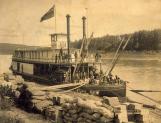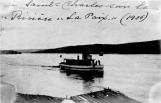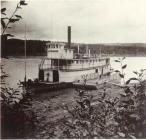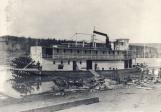1
The Peace River region of northern Alberta and British Columbia in the early 20th Century was an environment which engendered excitement and dreaming. The signing of Treaty 8 with the local First Nations (the Dunne-za) in 1899 opened the area to potential widespread settlement and economic activity and it was rapidly transformed. In this process a distinctive Peace River regional identity evolved, one that still exists today despite the Alberta-British Columbia provincial border running through it.The dreams and visions of individuals and organizations coming to the Peace River area were varied and included such things as: the spreading of the Christian faith to the region's First Nations and Metis populations and the creation of new Christian communities; the expansion of agricultural settlement and the establishment of new settlements and urban centres; the development of new industries and economies; the introduction of institutions such as schools, hospitals, and government.
A major component to all of these dreams was the navigation of the Peace River through the use of steamboat technology beginning with the S.S. St. Charles in 1903. There were no railways in the region yet and transportation was limited to overland trails and small scows and rafts on rivers and lakes. The introduction of steamboats allowed for regularly scheduled transportation of goods and people in larger quantities and faster than ever before, in short, the fulfillment of dreams.
Steamboats rapidly became an integral part of most activities and indeed, they became symbolic of the changes being introduced to the area. Not only did steamboats play a major role in the development of new economies and institutions but they were also a key part of the shaping of several communities on the Peace River and they helped to forge a new regional identity.
2
The S.S. D.A. Thomas near the Early Gardens on the Shaftesbury Trail near Peace River Crossing.Circa 1920s
Shaftesbury Trail, Alberta, Canada
 Credits:
Credits:Peace River Museum, Archives & Mackenzie Centre, 2008.056.001
3
This exhibit will be limited to the region known as the upper Peace River--the watershed of the Peace River from the Vermilion Chutes (a series of rapids) near the modern day Town of Fort Vermilion in northern Alberta to an unnavigable portion of the river called Hudson's Hope in British Columbia, a distance of roughly 900 kms.The lower Peace River, the stretch of river from the Vermilion Chutes eastward towards Lake Athabasca, had had steamboat service as early as the 1880s. The earliest steamboat was the S.S. Grahame, built by the Hudson's Bay Company to connect the lower Peace River to the Athabasaca and Mackenzie River systems. The S.S. Grahame and other steamboats to follow on the lower Peace River could not advance upriver past the Vermilion Chutes, cutting off the upper Peace River from steamboat service for two decades.
4
The S.S. Grahame on the Athabasca River.Post 1883
Athabasca River, Alberta, Canada
 Credits:
Credits:Peace River Museum, Archives & Mackenzie Centre, 87.1506.007
6
In this exhibit an attempt will be made to look at the dreams held by individuals and organizations for the Peace River and the role played by steamboat technology in each.The first of these dreams is that held by the Oblates and Bishop Emile Grouard in their creation of the "mission boats", which included the S.S. St. Charles, in their quest to establish and maintain Roman Catholic missions on the Peace River in the late 19th and early 20th centuries.
7
Bishop Emile Grouard.Early 20th Century
Grouard, Alberta, Canada
 Credits:
Credits:Alberta Historic Sites, Reference Collection
8
The S.S. St. Charles.1906
Peace River Crossing, Alberta, Canada
 Credits:
Credits:Missionary Oblates, Grandin Collection at the Provincial Archives of Alberta, OB 13501
9
Next will be the attempt of the Hudson's Bay Company to maintain their economic supremacy in the Peace River region through the use of steamboats (including the S.S. Peace River, the steam tug Messenger, the S.S. Athabasca River and later the S.S. D.A. Thomas).10
The S.S. Peace River.Circa 1905-1916
Peace River Crossing, Alberta, Canada
 Credits:
Credits:Peace River Museum, Archives & Mackenzie Centre, 73.568.002
11
The S.S. Peace River.Circa 1908-1915
Peace River Crossing, Alberta, Canada
 Credits:
Credits:Peace River Museum, Archives & Mackenzie Centre, 81.1197.002
12
The Hudson's Bay Company steam tug, the Messenger, at Peace River Crossing.1911
Peace River Crossing, Alberta, Canada
 Credits:
Credits:University of Alberta Archives, Hulbert Footner Fonds, UAA 77-147-41
13
The S.S. Athabasaca River.Circa 1914-1916
Athabasca River, Alberta, Canada
 Credits:
Credits:Peace River Museum, Archives & Mackenzie Centre, 76.689.006
